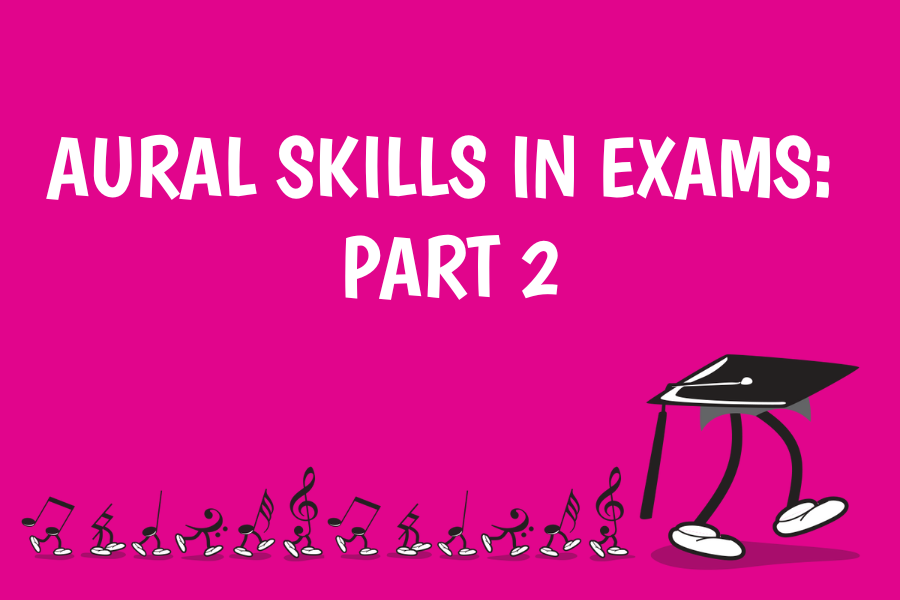Aural Skills in Exams: Part 2

In Part 1 of this blog I talked about ways to get students to sing more confidently, as well as the three ‘essentials’ for good aural training: Singing, Practising and Memorising.
Now, let’s look into some of the sections of the exam more closely.
Rhythm Clapping and Metre
The rhythm section of the aural test is very often a weak spot for students. There are two possible reasons for this: the first is that the student finds it hard to memorise the whole rhythm before clapping it back, and the second is that the student has not had a lot of experience at isolating rhythm from a piece or from a melody.
One way to find out whether a student is having trouble with memory or clapping would be to do a rhythm dictation. In other words, ask the student to write the rhythm instead of clapping it. If the student can’t clap it but can write it, they just need to practise clapping. If the student cannot do either, some remedial memorisation work is needed, starting with very short patterns.
To work on clapping, ask the student to clap passages from their own pieces at random times in every lesson, either before or after playing the passage, both with and without the teacher playing or clapping along. At a more advanced level, play an excerpt of an unknown piece to the student once and then ask the student to clap the melodic part from memory. This can be done either with the teacher playing an instrument or with a CD recording. Recordings with more than one instrument are good for advanced levels, as the student is really forced to listen and isolate one part. This can also be achieved with a piano. For students with good pitch, memorising the melody can act as a mental ‘glue’ for memorising rhythms.
Duple or Triple?
An easy tip for students who have trouble distinguishing between these is that duple time sounds like a march, and triple time sounds like a waltz. (Many students don’t know what a waltz is… this is a prudent thing to cover!) The important thing is for the student to be able to get a feel for the beat/pulse as soon as they hear the test, rather than trying to figure it out after they’ve clapped it back.
Singing Back the Melody
The first thing is that the student needs to be able to both memorise AND sing for this section, as discussed in Part 1 of this blog. Visual learners can imagine the line and shape of the melody. If it helps, ask students to assign two contrasting colours to the high and low parts of the melody, or to think of each of the pitches in different colours or shades. Some students say that the high notes are visually brighter and the low notes are more mellow, for example.
For kinaesthetic learners, taking this a step further and actually drawing the shape of the melody line with a finger in the air can be a great way for them to memorise a melody.
It is easy to practice this skill all the time: students should be able to sing the melodic line of their own pieces. Like the clapping of rhythms, this can be done every lesson, and it should not take long. Singing of parts of pieces should be part of the student’s practice routine at home.
Great practice for piano students is to sing the bass line as an alternative to the right hand melody. This is also good practice for hearing the lower note in higher/lower note identification exercises (see below).
Singing Higher/Lower/Middle notes
Most teachers agree that the lower note is harder for students to hear than the higher note. This is because the harmonics of higher pitches are more easily picked up by the ear. So lots of practice is required to get used to picking out the lower note – it’s a skill that needs to be developed gradually over time, and cannot be taught quickly if the student is struggling.
For two-note examples, it is great practice to ask the student to sing both notes, to make sure that they are able to separate them in their mind. It is important to be able to hear both notes clearly and separately before being able to isolate the higher or lower note. After a few weeks on this exercise, being able to sing one note or the other will be much easier, as the student can hear both notes but just chooses the higher or lower one to sing out loud.
For the visual learners, the lower note can be described to the student as being more ‘anchored’ while the higher note ‘floats’ above it. As described in the “melody” section, piano students can sing the bass line of their piece while playing the melody. For instruments other than the piano, you can help out by playing two parts on a piano, or using a recording.
To be able to sing the middle note of a triad, the student needs to be able to sing all three notes first. It is usually easiest to sing the notes of a triad descending, as the top note is easiest to hear. After distinguishing all three notes mentally (or by humming them extremely softly!) it is then much easier to pick out and sing the middle note.
Singing and/or Recognising Triads
For visual learners, inversions of triads can be recognised by visualising the intervallic relationships between notes in the chord. This can also help those good at hearing intervals, as it can be heard as much as it can be visualised:
Root position – small gap at bottom, small gap at top.
First inversion – small gap at bottom, large gap at top.
Second inversion – large gap at bottom, small gap at top.
(Here ‘small gap’ is a 3rd and ‘large gap’ is a 4th. Many students may find it easier simply to name the intervals.)
Kinaesthetic learners should play the inversions on their instruments a number of times before trying to sing them. They should try remembering what the inversions feel like on their own instrument, and better still, with their voice.
Another effective method (although sometimes less reliable) is to sing the notes of the triad from the top down and try to determine where the root is – i.e. when the triad feels ‘finished’.
Root position – sounds finished, no need to keep going
First inversion – needs one more note to sound finished
Second inversion – needs two more notes to sound finished
In Part 3 of this blog series I will list some helpful tips for recognising intervals as well as some great melodic references!!!
